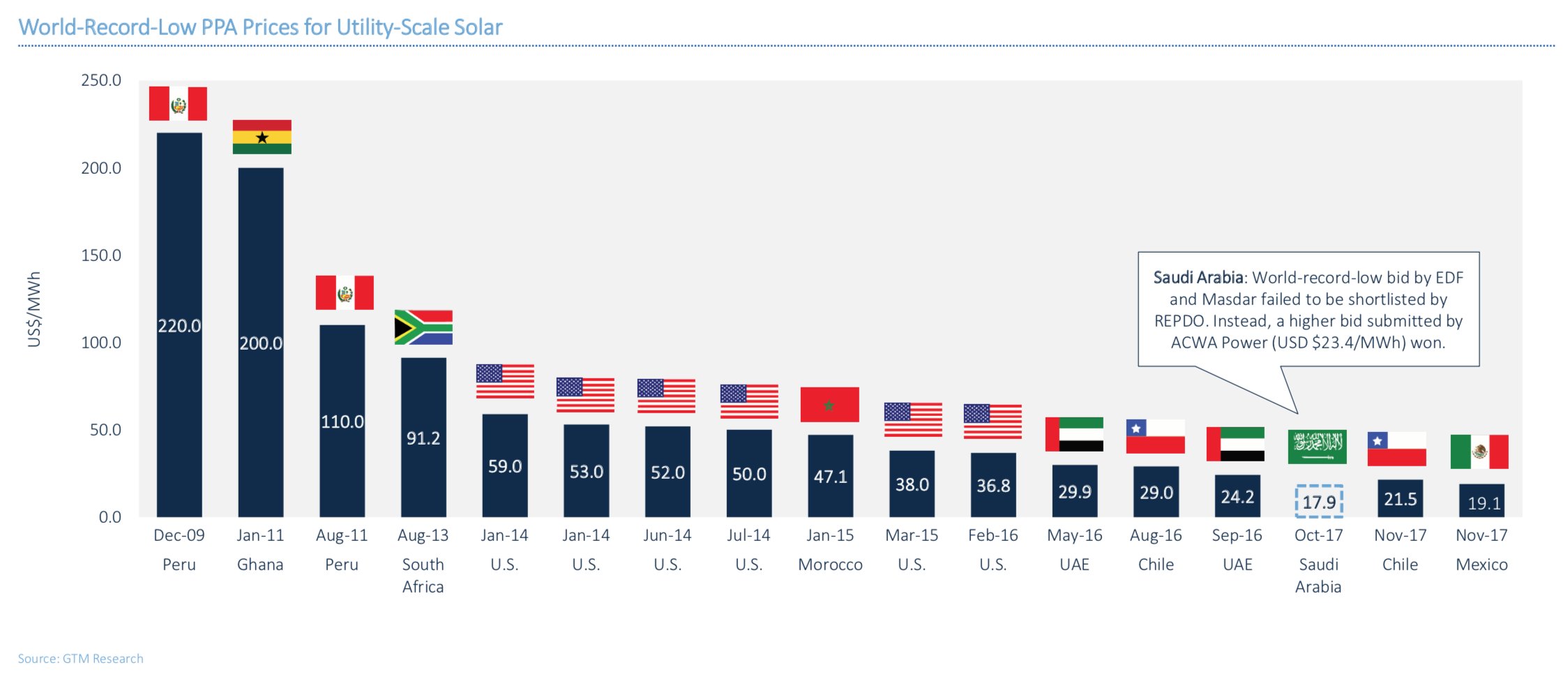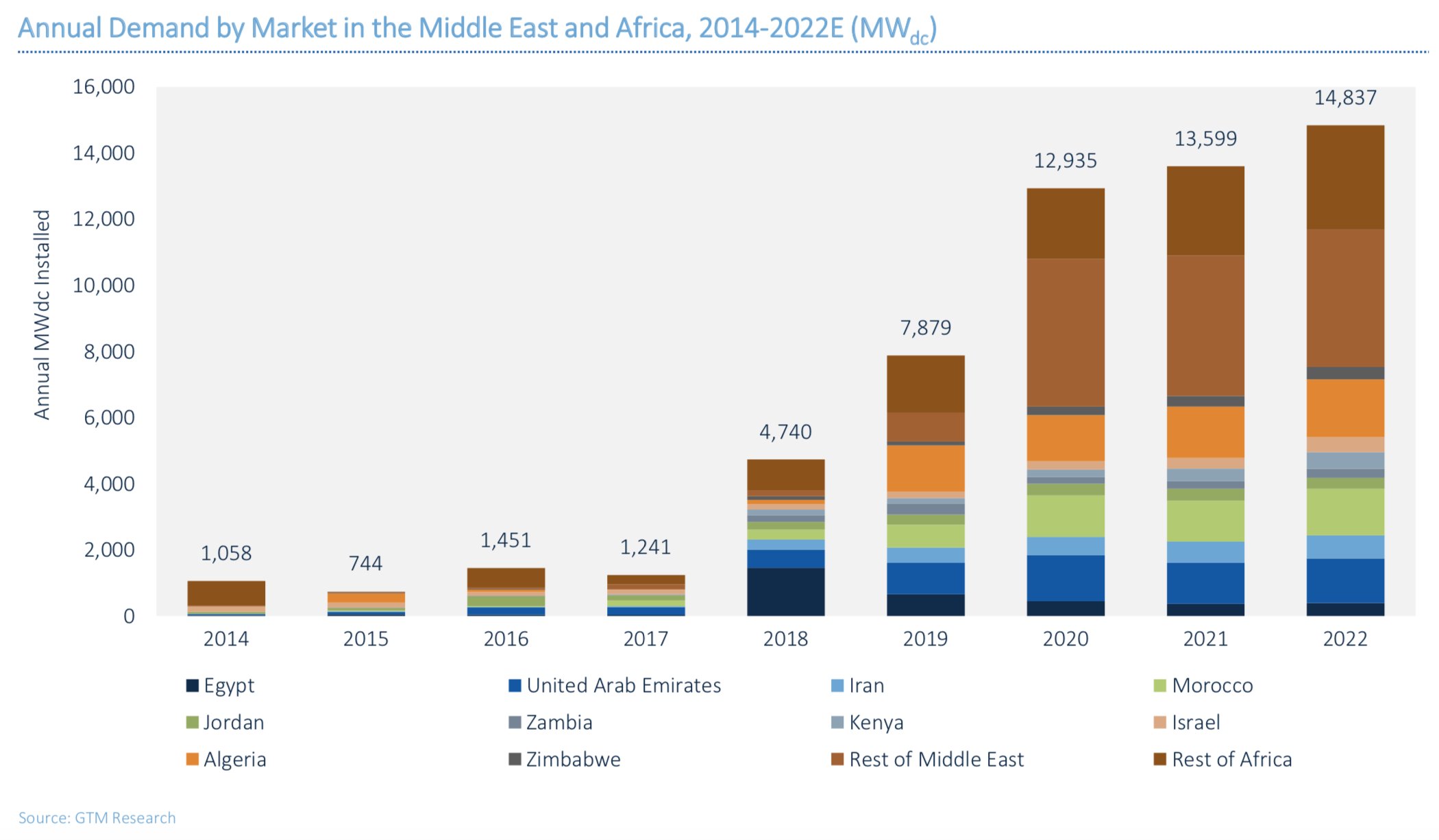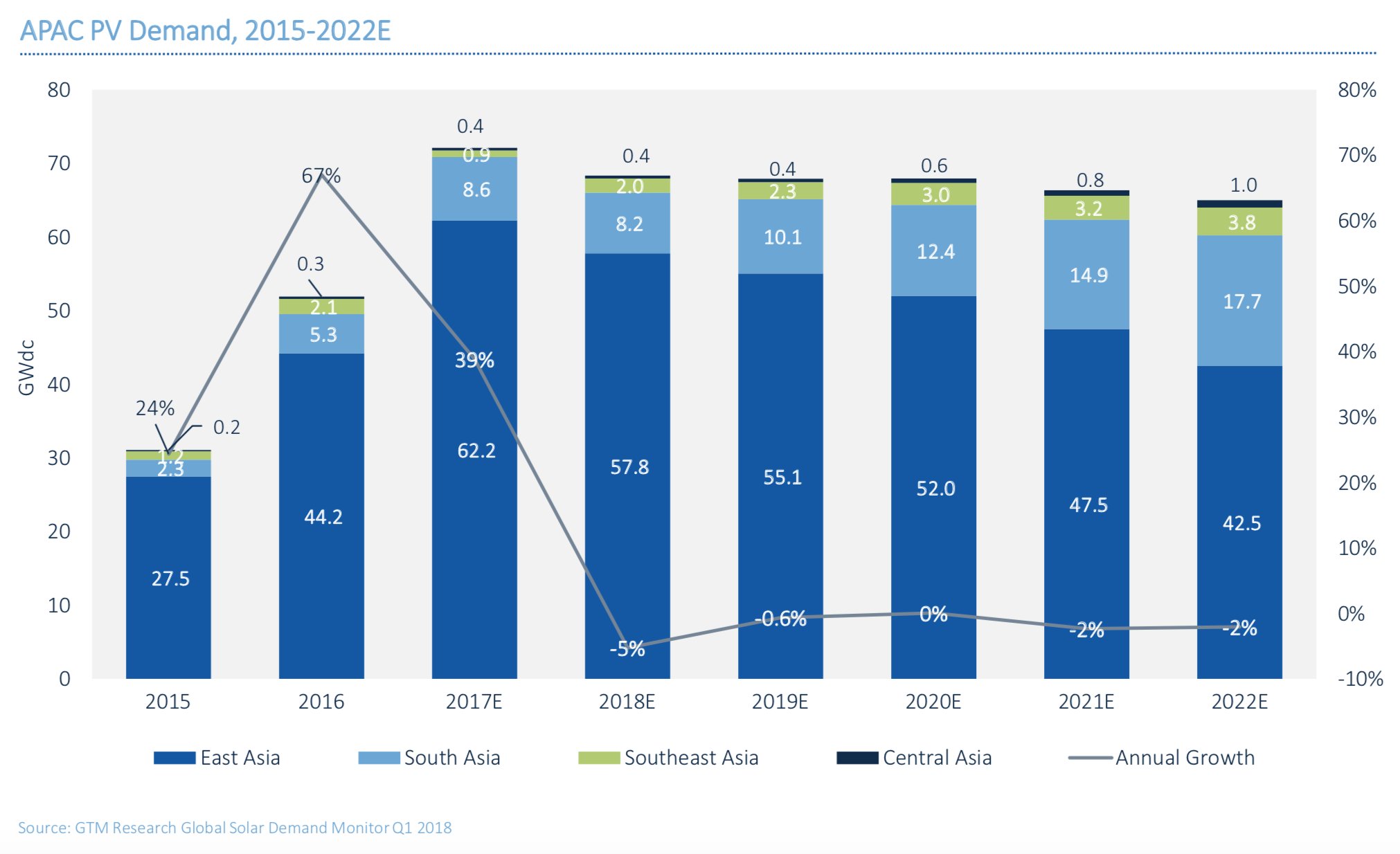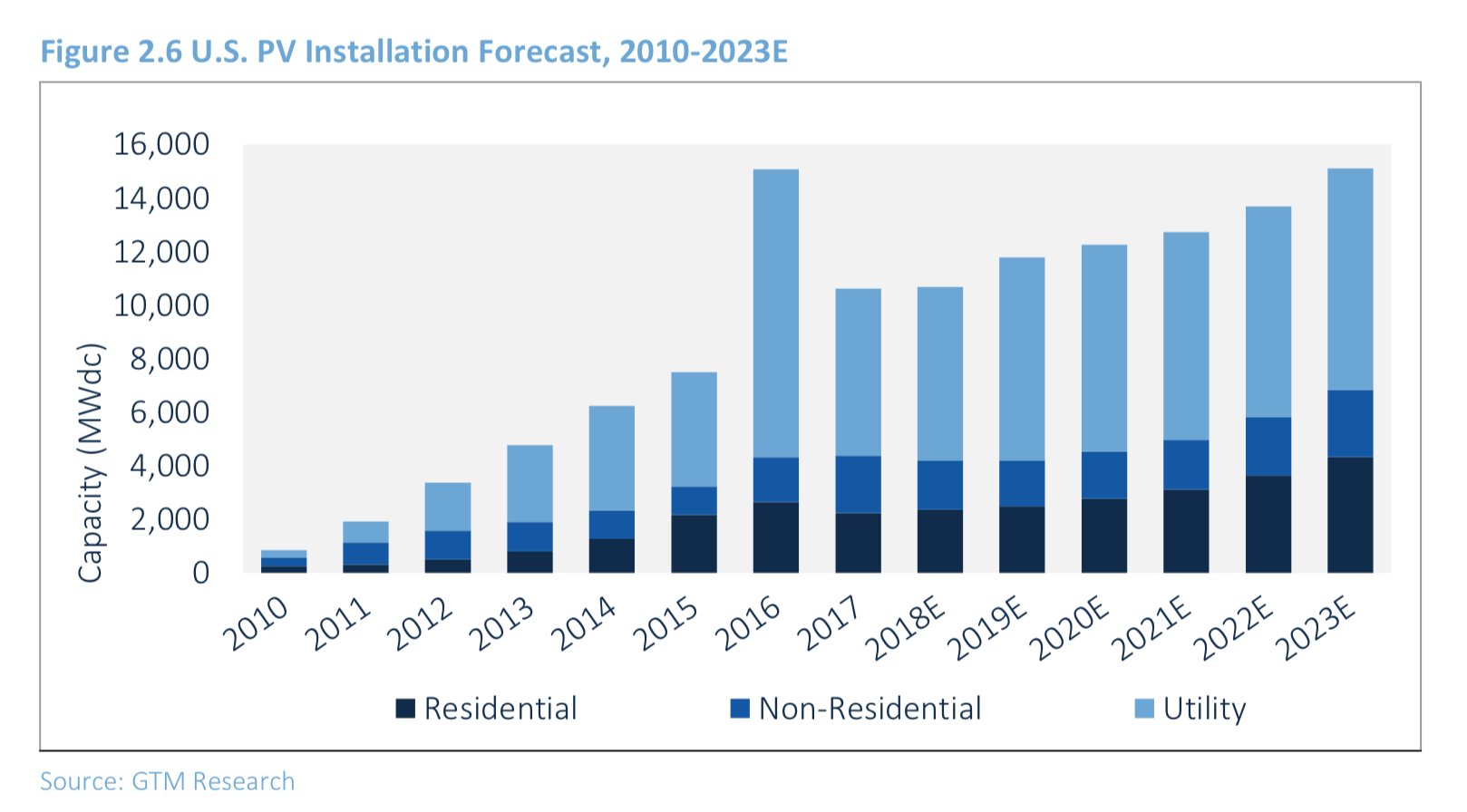The continuation of the solar coaster was inevitable.
In 2016, the U.S. market grew 95 percent, the largest year of growth in its history and a near doubling of the previous installation record. As the calendar turned to 2017, the U.S. also met its SunShot goal of sub-$1 per watt utility fixed-tilt pricing. Meanwhile, PPA prices continued to drop through the floor.
But Trump’s year of tariffs and tax changes turned an upward climb into a vertical loop. GTM Research predicts the two policy changes will cause a 13 percent drop in installations compared with the 2018-2022 base case.
Policy shifts in China and other leading markets are causing similar moderations in growth. This is creating a tipping point that GTM Research has expected for years — as solar nears maturity, emerging markets are playing a more important role in the overall growth of global installs.
Though the world’s top four markets will decline by a combined 6.5 percent in 2018, annual demand will still grow 6 percent. In 2018, 13 markets will top 1 gigawatt. By 2024 that number will hit 22.
“One of the main trends we’re seeing is the top markets declining and the rest of the countries picking up,” said Rishab Shrestha, a solar analyst at GTM Research and an author of the Global Solar Demand Monitor report. “That’s building up the growth that we see.”
GTM Research’s projection puts 2018 demand at 104 gigawatts, a moderate increase from the 98 gigawatts installed globally in 2017. But Shrestha said emerging markets “are just getting started.”
Looking ahead to 2022, PV demand from Europe, Latin America and the Middle East will continue to grow, while demand from North America and Asia will remain stable.

Tier 2 countries are the ones to watch, according to Shrestha. Tariff pressure and policy changes in the U.S., China and India have made many environments less friendly for growth. But globally falling prices have opened up solar markets in a wider range of countries.

While the United States historically dominated records for low PPA prices, Chile, Saudi Arabia, Mexico and the United Arab Emirates all recently hit all-time lows. Mexico currently holds the title with a bid at $19.10 per megawatt-hour — half the price of a record set less than two years ago. GTM Research analysts note that prices “haven’t hit the bottom yet.”

According to GTM Research, a commitment to tenders will continue to drive further declines. Those programs are cropping up in more countries: 54 national markets in the last quarter of 2017 as opposed to 32 in H2 2016.
Tendering schemes are now moving to more areas within Africa, Europe, and other regions. Colombia plans to hold its first tender before the end of May; Vietnam announced an auction program in September; and Algeria also has a tender for 4 gigawatts in the works.
For a nascent market, 4 gigawatts is big. Overall, the market in the Middle East and Africa will grow over 380 percent.

Many of the projects fueling that increase are monsters. The largest is Egypt’s 1.8-gigawatt Benban Solar Park located on 37 square kilometers of desert outside Aswan. Another possible project, which Saudi Arabia’s SoftBank announced in late March, would blow Benban away at an “unprecedented” 200 gigawatts. (There's still a lot of uncertainty around whether Saudi Arabia and SoftBank can pull off that scale, however.)
“That highlights the kind of ambition Middle Eastern regions are exhibiting,” said Shrestha.
Though Middle Eastern governments see solar as key to diversifying away from burning oil for electricity, GTM Research analysts say any big promises should be viewed with a critical eye. Indeed, Saudi Arabia’s Renewable Energy Project Development Office rejected an eye-popping sub-2 cent per watt bid for a 300-megawatt project with bifacial modules.
GTM Research projects demand in the Middle East and Africa will grow from just under 5 gigawatts in 2018 to almost 15 gigawatts through 2022.
Latin America will nearly double demand from 5.6 gigawatts in 2018 to just over 11 gigawatts in 2022.

Mexico accounts for much of that growth as it works to meet increasingly ambitious clean energy goals. The country also came in at the top of a new GTM Research analysis on market attractiveness, which assesses the positive economics and policy for national PV markets. Five Latin American countries rank in the top 10.
Though it didn’t make the top of that list, Brazil will also play an increasingly important role in growing Latin American demand. Analysts note that consolidation will be key for Brazil’s wide-ranging installer network in streamlining processes for net energy metering and community solar programs. In Mexico, auctions have brought rock-bottom PPA prices and the headlines to match, but a 25 percent failure rate could spell trouble.
Shrestha categorizes Europe as a “re-emerging” market. Though growth in Europe will be less explosive than in other regions, resource targets and auctions will help add an average of 14 gigawatts a year through 2022. Over two-thirds of additions will be in Germany, France, Turkey, Italy, the Netherlands and Spain.

In an April technology-neutral auction in Germany, solar projects came away with all of the capacity. The wind industry decried it as a “failure” and an “unsuitable” way to promote clean energy. But there's now more talk of subsidy-free solar projects in Germany, which have already landed elsewhere.
Asia surpassed Europe in growth rates at the turn of the decade. But that trend is reversing. Annual growth in the Asia-Pacific region took a nosedive between 2016 and 2017 and will continue to fall through the end of this year. Slowdowns in China, India and Japan fueled much of that downturn.

Local manufacturers in India are apprehensive. The possibility of antidumping duties on Chinese and other Asian modules and module products is increasing anxiety. Changes to the tax scheme for goods and services, along with a new port tax, are compounding the problem.
China has shifted its focus from utility-scale to distributed solar. Distributed projects could grow by more than 250 percent this year over 2017. However, demand for utility-scale projects could fall by 33 percent by 2022, representing tens of gigawatts of lost demand. Still, China will remain an important market.
“It’s still a very meaningful size, globally,” said Shrestha.
It's a similar story in the United States, where demand will creep up just a bit from 10.6 gigawatts to 13.6 gigawatts in 2022.

Though U.S. utility-scale solar will continue to grow through 2023, it will come at more modest pace than under a tariff-free scenario. In 2019, GTM Research projects 17 percent growth for utility-scale solar. That will modulate between 2020 and 2022 based on tariffs pushing project timelines back. On the residential side, growth rates will fall below 10 percent through 2020.
Shrestha said the continued momentum, though limited, speaks to the general health of the market. “In terms of global market, I would say that the U.S. is considerably more mature,” said Shrestha. “The market is more resilient in the face of all these other fluctuations caused by trade restrictions and trade tariffs.”